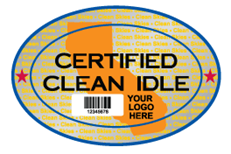So far in my CARB article series, we’ve covered the Statewide Truck and Bus rule, the TRU regulation, and the GHG regulation. There are four other California Air Resources Board (CARB) regulations on trucks being enforced and these actually make up the bulk of enforcement actions being taken against truckers (citations).
Emission Control Label (ECL) Inspection
No 1974 or newer diesel-powered heavy-duty commercial vehicle shall operate in California without evidence that, at the time of manufacture, the installed engine met emission standards at least as stringent as applicable federal emission standards for the model year of the engine. CARB shall base its determination on whether an engine meets the above requirement by inspecting the Emission Control Label (ECL) affixed to the vehicle’s engine. The ECL must be legible and maintained in the original location it was installed. The data on the label must correspond to the serial number stamped on the engine block (i.e. must be correct label for the engine.)
A vehicle owner found in violation of the above requirement is potentially subject to two distinct penalties:
- Tampered (missing) ECL carries a $300 penalty.
- The regulation presumes an engine without an ECL (or other documentation from the engine manufacturer) did not meet US EPA standards at the time of manufacture, which carries a $500 penalty.
If your truck engine’s ECL is missing or unreadable, you’ll need to contact your truck dealer or engine distributor for a replacement ECL. Costs for replacing an ECL are inconsistent so shop around.
Heavy-Duty Diesel Vehicle Inspection Program (HDDVIP) and Periodic Smoke Inspection Program (PSIP)
The HDDVIP tests for allowable levels of smoke (opacity) coming from your exhaust stacks. The testing method is often referred to as the “snap-idle” test where you punch the accelerator three times and allow the engine to return to idle. The primary enforcement targets are trucks with pre-1991 engines and fines can be as high as $1,800.
The PSIP affects only trucks of California-based fleets with two or more trucks (a single-truck owner-operator is excluded). Fleets are required to perform annual smoke and tamper inspections on all trucks over four model years of age. The inspection must be performed using an SAE J1667 smoke meter and records must be kept for two years. Penalties are up to $500 per vehicle, per year.
Idling Reduction Program
 Idling a diesel engine within the borders of California for more than 5 minutes is prohibited. Fines begin at $300 and can be as high as $1,000 per day. A truck equipped with a low NOx engine can be idled if the truck displays a California Clean Idle sticker.
Idling a diesel engine within the borders of California for more than 5 minutes is prohibited. Fines begin at $300 and can be as high as $1,000 per day. A truck equipped with a low NOx engine can be idled if the truck displays a California Clean Idle sticker.
For trucks equipped with an auxiliary power unit (APU), if the truck has an EPA-certified 2007 or newer diesel engine, the APU must meet the following additional equipment requirements:
- Be fitted with a verified Level 3 particulate control device (85% particulate reduction efficiency)
- Have its exhaust plumbed into the vehicle's exhaust system upstream of the particulate matter after-treatment device
- In addition, an approved "Verified Clean APS" label must be affixed to the hood of the vehicle
There are no additional equipment requirements in order to legally use an older APU for trucks equipped with engines older than 2007.
Drayage Regulation
All trucks going into a California port or intermodal rail yard must be registered in CARB’s Drayage Truck Registry. This regulation bans older trucks from entering those facilities based on a quicker compliance schedule compared to the Statewide Truck and Bus rule. As of December 31, 2009 all trucks equipped with a pre-1994 engine are banned and trucks equipped with 1994 thru 2006 MY engines must have a DPF reducing emissions by 85%. Ports and rail yards are required to report non-compliant trucks to CARB who in turn will issue citations to violators.
Enforcement
CARB’s inspectors do not possess “primary police power” which means they cannot pull you over similar to an actual law enforcement officer. However, they do have the legal authority to go onto private property and enforce air quality regulations. Also, the CHP must make their fixed scale locations available for CARB inspection efforts.
Besides roadside inspections, CARB’s other primary means of enforcement is through “supply chain accountability”. That means brokers, shippers, and receivers are being held accountable for the compliance of those they contract with for transportation services.
Increasingly, brokers, shippers, and receivers are requesting proof of CARB compliance in the form of a CARB Compliance Certificate to protect themselves from liability. The Certificate can be automatically downloaded from CARB’s registration systems after entering the required data.
I have received numerous calls from truckers both inside and outside California who have run into problems loading for some shippers because they don’t have the Compliance Certificates. Most of the truckers have been operating late-model compliant equipment that technically is not required to be registered in most CARB databases. However, brokers and shippers are increasingly practicing a form of “defensive medicine” to protect themselves from CARB enforcement actions by requiring everyone they contract with to supply the Certificates.
An example of CARB’s enforcement intentions can be found in a Regulatory Guidance issued this past February (see: http://www.arb.ca.gov/diesel/tru/documents/guidance_broker-shipper-receiver.pdf) concerning the TRU regulation.
That wraps up our four-part “Understanding CARB” article series. There is a lot of information to know regarding CARB, so feel free to ask questions in the comments below.